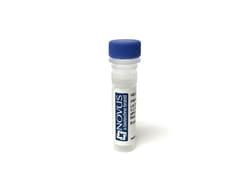Fas/TNFRSF6/CD95 Antibody (B-R18) - Azide and BSA Free, Novus Biologicals™
Mouse Monoclonal Antibody
Manufacturer: Fischer Scientific
The price for this product is unavailable. Please request a quote
Antigen
Fas/TNFRSF6/CD95
Concentration
1.0 mg/mL
Applications
Flow Cytometry, Immunohistochemistry (Frozen), Immunofluorescence, CyTOF
Conjugate
Unconjugated
Host Species
Mouse
Research Discipline
Apoptosis, Cancer, Cell Biology, Death Receptor Signaling Pathway, Diabetes Research, Inhibitors Activators and Regulators
Formulation
PBS with No Preservative
Gene ID (Entrez)
355
Immunogen
Recombinant human CD95 protein
Primary or Secondary
Primary
Content And Storage
Store at 4C short term. Aliquot and store at -20C long term. Avoid freeze-thaw cycles.
Clone
B-R18
Dilution
Flow Cytometry : 0.5 - 1 ug/million cells in 0.1 ml, Immunohistochemistry-Frozen : 0.5 - 1.0 ug/ml, Immunofluorescence : 0.5 - 1.0 ug/ml, CyTOF-ready
Classification
Monoclonal
Form
Purified
Regulatory Status
RUO
Target Species
Human
Gene Alias
Apo-1 antigen, apoptosis antigen 1, Apoptosis-mediating surface antigen FAS, APT1FASTM, CD95 antigen, CD95ALPS1A, Fas (TNF receptor superfamily, member 6), Fas AMA, Fas antigen, FAS1, FASLG receptor, TNFRSF6member 6, tumor necrosis factor receptor superfamily member 6
Gene Symbols
FAS
Isotype
IgG1 κ
Purification Method
Protein A or G purified
Test Specificity
MAb B-R18 specifically recognizes CD95, also known as Fas, a transmembrane glycoprotein with a MW of 40-45kDa, containing 8kDa of N-glycosidic-linked polysaccharide. It is a receptor for TNFSF6/FASLG, a member of the nerve growth factor receptor/tumor necrosis factor superfamily, mediating receptor-triggered apoptosis. The adapter molecule FADD recruits caspase-8 to the activated receptor. The resulting death-inducing signaling complex (DISC) performs caspase-8 proteolytic activation, which initiates the subsequent cascade of caspases (aspartate-specific cysteine proteases) mediating apoptosis. FAS-mediated apoptosis may have a role in the induction of peripheral tolerance, in the antigen-stimulated suicide of mature T-cells, or both. The secreted isoforms 2 to 6 block apoptosis (in vitro). CD95 antigen is expressed on the surface of various cell types, preferentially on the CD45RAlow CD45ROhigh subset of memory T lymphocytes.
Description
- Fas Receptor/TNFRSF6/CD95 Monoclonal specifically detects Fas Receptor/TNFRSF6/CD95 in Human samples
- It is validated for Flow Cytometry, Immunohistochemistry, Immunocytochemistry/Immunofluorescence, Immunohistochemistry-Frozen, Functional, Immunofluorescence, CyTOF-ready.
